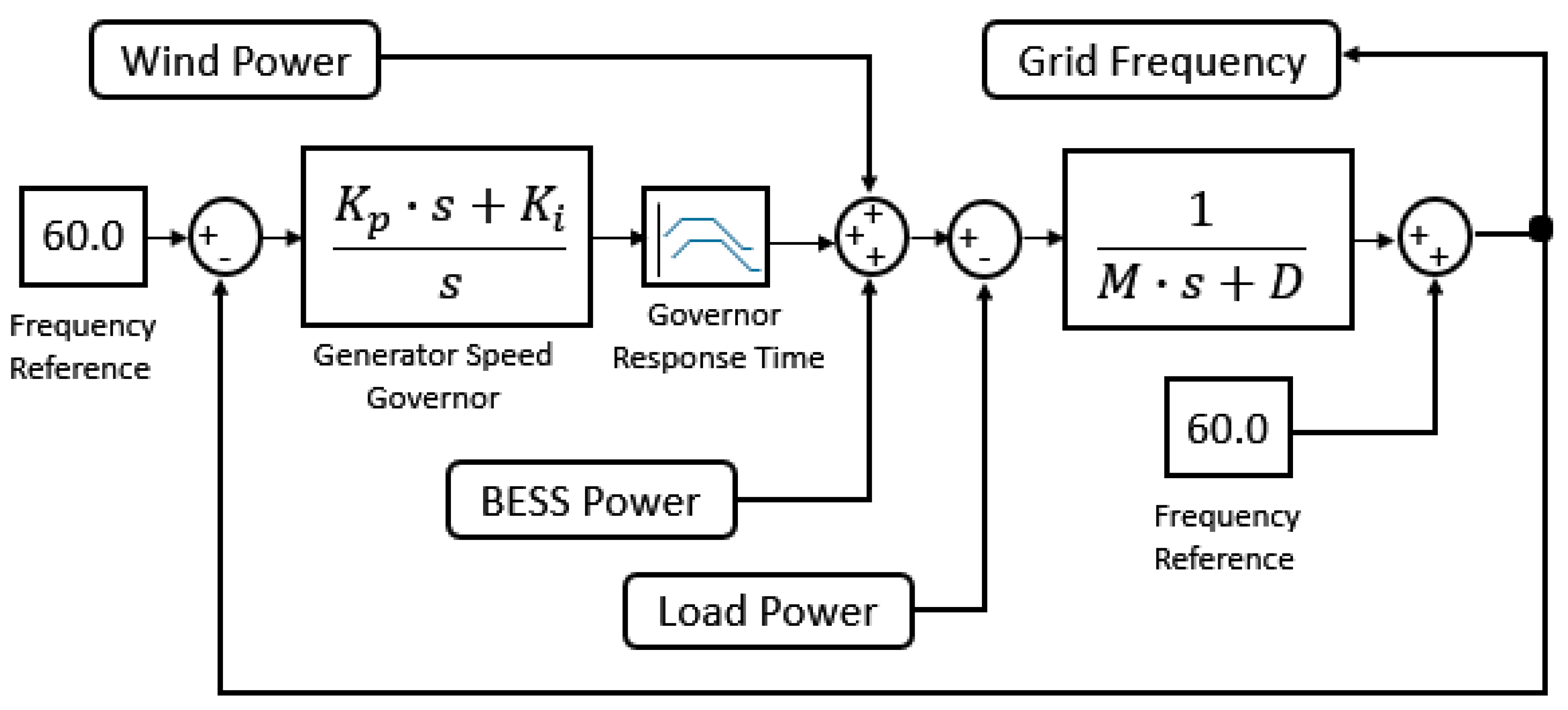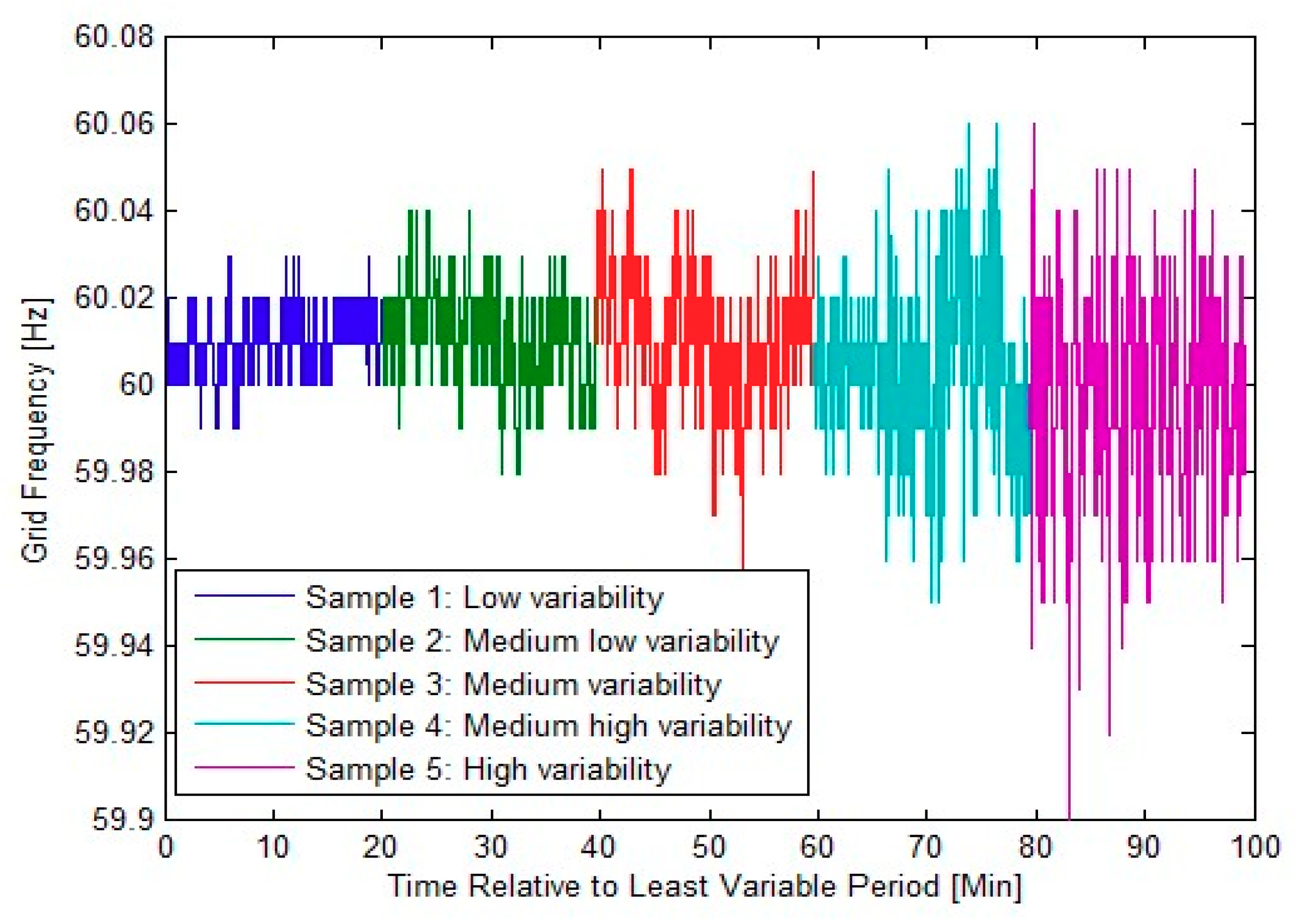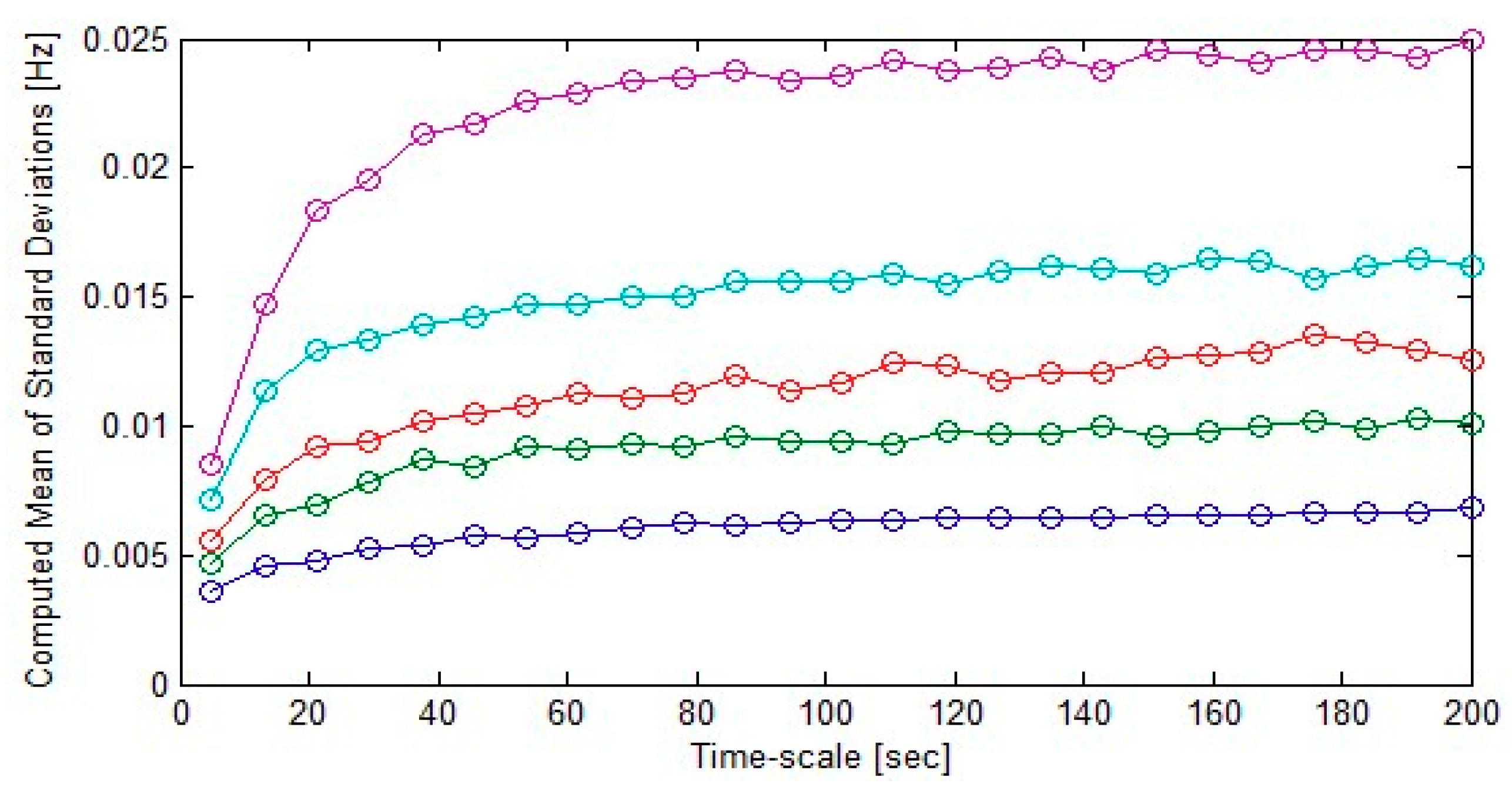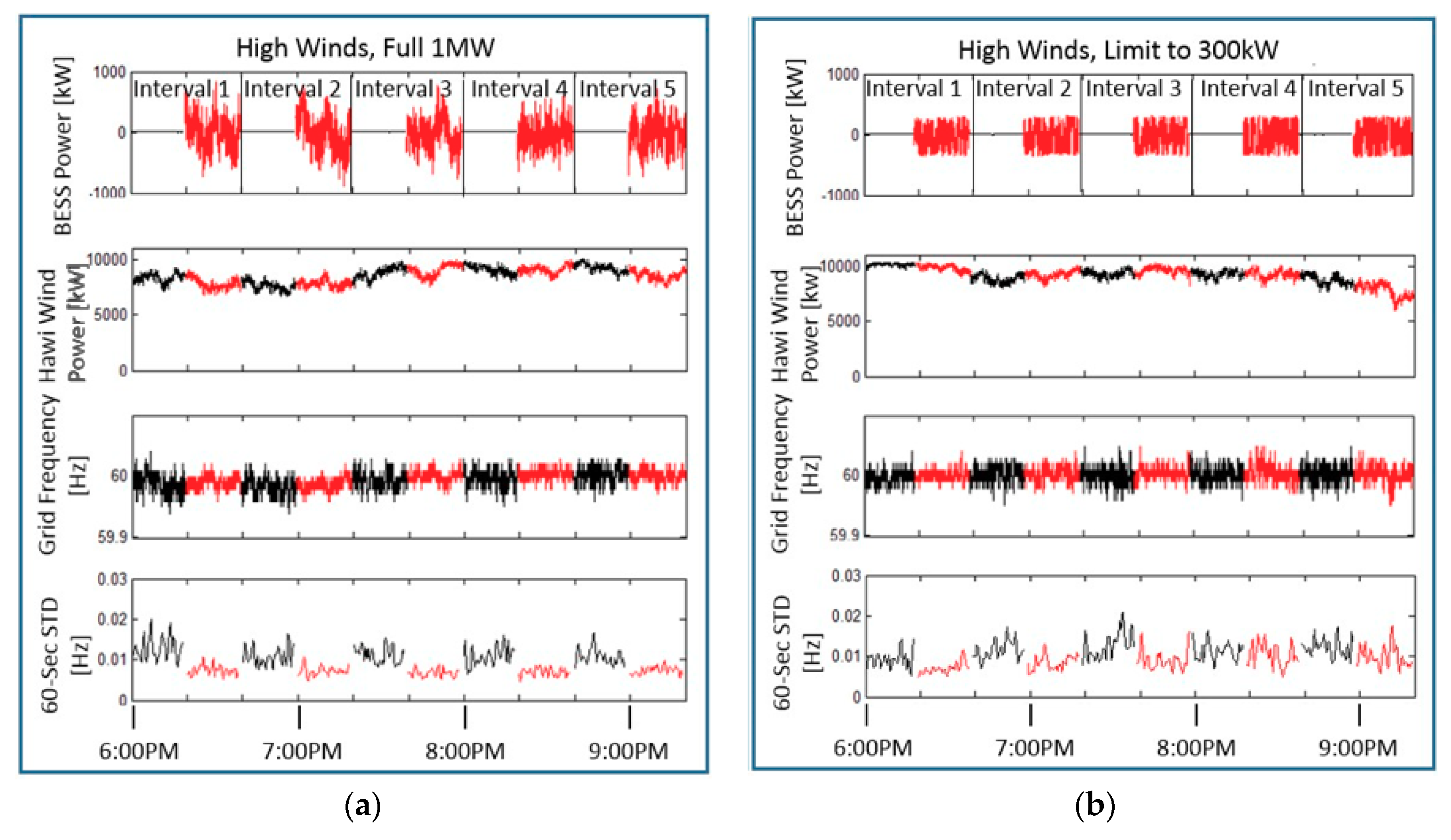Evaluation of a 1 MW, 250 kW-hr Battery Energy Storage System for Grid Services for the Island of Hawaii
Abstract
:1. Introduction
2. BESS Development and Installation
- Collects and stores all data on the cloud server
- Utilizes data from the BMS (e.g., SOC and cell temperatures) and the inverter system in the PCS to determine any limits on available power
- Processes the measured data to develop power commands using real-time control algorithms
- Executes manual commands inputted by a user
3. Control Algorithms
3.1. Frequency Response: Algorithm Development and Testing
3.2. Wind Smoothing: Algorithm Development and Testing
- the wind farm’s power output may not change more than 1 MW over any two seconds interval,
- the wind farm’s power output may not change more than 2 MW over any one-minute interval,
- the one-minute average of power output changes over any 2 s intervals may not exceed 300 kW.
3.3. Early Testing and Lessons Learned
4. Summary and Future Work
Author Contributions
Funding
Acknowledgments
Conflicts of Interest
References
- Eftekharnejad, S.; Vittal, V.; Heydt, G.T.; Keel, B.; Loehr, J. Impact of increased penetration of photovoltaic generation on power systems. IEEE Trans. Power Syst. 2013, 28, 893–901. [Google Scholar] [CrossRef]
- Ulbig, A.; Borsche, T.S.; Andersson, G. Impact of low rotational inertia on power system stability and operation. arXiv, 2013; arXiv:1312.6435. [Google Scholar]
- Georgilakis, P.S. Technical challenges associated with the integration of wind power into power systems. Renew. Sustain. Energy Rev. 2008, 12, 852–863. [Google Scholar] [CrossRef] [Green Version]
- Hamsic, N.; Schmelter, A.; Mohd, A.; Ortjohann, E.; Schultze, E.; Tuckey, A.; Zimmermann, J. Increasing renewable energy penetration in isolated grids using a flywheel energy storage system. In Proceedings of the International Conference on Power Engineering, Energy and Electrical Drives, POWERENG 2007, Setubal, Portugal, 12–14 April 2007; pp. 195–200. [Google Scholar]
- Hawaii Clean Energy Initiative. Available online: http://www.hawaiicleanenergyinitiative.org/ (accessed on 27 November 2018).
- Rampazzoa, M.; Luvisottoa, M.; Tomasonea, N.; Fastellib, I.; Schiavettib, M. Modelling and simulation of a Li-ion energy storage system: Case study from the island of Ventotene in the Tyrrhenian Sea. J. Energy Storage 2018, 15, 57–68. [Google Scholar] [CrossRef]
- El-Bidairia, K.; Nguyena, H.; Jayasinghea, S.; Mahmoudb, T.; Penesisa, I. A hybrid energy management and battery size optimization for standalone microgrids: A case study for Flinders Island, Australia. Energy Convers. Manag. 2018, 175, 192–212. [Google Scholar] [CrossRef]
- Rodrigues, E.; Godina, R.; Catalão, J. Modelling Electrochemical Energy Storage Devices in Insular Power Network Applications Supported on Real Data. Appl. Energy 2017, 188, 315–329. [Google Scholar] [CrossRef]
- Cabrera, P.; Lund, H.; Carta, J. Smart renewable energy penetration strategies on islands: The case of Gran Canaria. Energy 2018, 162, 421–443. [Google Scholar] [CrossRef]
- Notton, G. Importance of Islands in Renewable Energy Production and Storage: The Situation of the French Islands. Renew. Sustain. Energy Rev. 2015, 47, 260–269. [Google Scholar] [CrossRef]
- Dunn, B.; Kamath, H.; Tarascon, J.-M. Electrical energy storage for the grid: A battery of choices. Science 2011, 334, 928–935. [Google Scholar] [CrossRef] [PubMed]
- Koohi-Kamali, S.; Tyagi, V.; Rahim, N.; Panwar, N.; Mokhlis, H. Emergence of energy storage technologies as the solution for reliable operation of smart power systems: A review. Renew. Sustain. Energy Rev. 2013, 25, 135–165. [Google Scholar] [CrossRef]
- Beaudin, M.; Zareipour, H.; Schellenberglabe, A.; Rosehart, W. Energy storage for mitigating the variability of renewable electricity sources: An updated review. Energy Sustain. Dev. 2010, 14, 302–314. [Google Scholar] [CrossRef]
- Castillo, A.; Gayme, D.F. Grid-scale energy storage applications in renewable energy integration: A survey. Energy Convers. Manag. 2014, 87, 885–894. [Google Scholar] [CrossRef]
- Hidalgo-León, R.; Siguenza, D.; Sanchez, C.; León, J.; Jácome-Ruiz, P.; Wu, J.; Ortiz, D. A survey of battery energy storage system (BESS), applications and environmental impacts in power systems. In Proceedings of the Ecuador Technical Chapters Meeting (ETCM), Salinas, Ecuador, 16–20 October 2017; pp. 1–6. [Google Scholar]
- Hernández, J.; Gyuk, I.; Christensen, C. DOE global energy storage database—A platform for large scale data analytics and system performance metrics. In Proceedings of the 2016 IEEE International Conference on Power System Technology (POWERCON), Wollongong, NSW, Australia, 28 September–1 October 2016; pp. 1–6. [Google Scholar]
- Consiglio, L.; Di Lembo, G.; Noce, C.; Eckert, P.; Rasic, A.; Schuette, A. Performances of the first electric storage system of ENEL Distribuzione. In Proceedings of the AEIT Annual Conference 2013, Mondello, Italy, 3–5 October 2013. [Google Scholar]
- Koller, M.; Borsche, T.; Ulbig, A.; Andersson, G. Review of grid applications with the Zurich 1 MW battery energy storage system. Electr. Power Syst. Res. 2015, 120, 128–135. [Google Scholar] [CrossRef]
- Swierczynski, M.; Stroe, D.-I.; Stan, A.-I.; Teodorescu, R.; Laerke, R.; Kjaer, P.C. Field tests experience from 1.6 MW/400kWh Li-ion battery energy storage system providing primary frequency regulation service. In Proceedings of the 2013 4th IEEE/PES Innovative Smart Grid Technologies Europe (ISGT EUROPE), Lyngby, Denmark, 6–9 October 2013; pp. 1–5. [Google Scholar]
- Stein, K.; Tun, M.; Matsuura, M.; Rocheleau, R. Characterization of a Fast Battery Energy Storage System for Primary Frequency Response. Energies 2018. submitted. [Google Scholar]
- Dubarry, M.; Devie, A. Battery durability and reliability under electric utility grid operations: Representative usage aging and calendar aging. J. Energy Storage 2018, 18, 185–195. [Google Scholar] [CrossRef]
- Dubarry, M.; Devie, A.; Stein, K.; Tun, M.; Matsuura, M.; Rocheleau, R. Battery Energy Storage System battery durability and reliability under electric utility grid operations: Analysis of 3 years of real usage. J. Power Sources 2017, 338, 65–73. [Google Scholar] [CrossRef]
- Timothy, M. Spitler, “Lithium Ion Batteries”. U.S. Patent Application US20070092798A1, 23 October 2006. [Google Scholar]
- HNEI. Development of Real-Time Closed-Loop Control Algorithms for Grid-Scale Battery Energy Storage Systems; Hawaii Natural Energy Institute: Honolulu, HI, USA, 2014. [Google Scholar]
- Kundur, P.; Balu, N.J.; Lauby, M.G. Power System Stability and Control; McGraw-Hill Eduation: New York, NY, USA, 1994; Volume 7. [Google Scholar]
- Existing Wind Farms. Available online: https://web.archive.org/web/20150222124557/http://hawaiianelectric.com/heco/_hidden_Hidden/Renewable-Energy/Existing-Wind-Farms (accessed on 27 November 2018).















| Hawaii Natural Energy Institute (HNEI) | Project Management Algorithm Development Technical Oversight |
| Office of Naval Research (ONR) | Primary Funding Source Program Oversight |
| Department of Energy (DOE) | Partial Funding for Algorithm Development |
| Hawaii Electric Light Company (HELCO) | Infrastructure Development Planning Grid Management |
| Haw’i Renewable Development (HRD) | Host Site Owner Site Preparation |
| Altairnano | Battery System Manufacturer Systems Integration |
| Integrated Dynamics, Inc. (IDI) | Frequency Algorithm Development Software Development |
| SCADA Solutions | Wind Algorithm Development |
| Parker–Hannifin Company | Power Conversion System Supplier |
| A: Frequency Variability: Evening with Light Wind | |||
| Interval | Standard Deviation of Frequency w/BESS OFF [mHz] | Standard Deviation of Frequency w/BESS ON [mHz] | Percent Change |
| 1 | 13.4 | 8.3 | −38.1 |
| 2 | 10.3 | 6.0 | −41.7 |
| 3 | 9.0 | 7.7 | −14.4 |
| 4 | 7.1 | 6.7 | −5.6 |
| 5 | 6.6 | 8.1 | 22.7 |
| B: Frequency Variability: Evening with Medium Wind | |||
| Interval | Standard Deviation of Frequency w/BESS OFF [mHz] | Standard Deviation of Frequency w/BESS ON [mHz] | Percent Change |
| 1 | 15.9 | 8.6 | −45.9 |
| 2 | 13.5 | 7.9 | −41.5 |
| 3 | 14.3 | 8.8 | −38.5 |
| 4 | 12.6 | 7.2 | −42.9 |
| 5 | 11.4 | 9.5 | −16.7 |
| A: 60-Second Frequency Variability: 1000 kW Limit | |||
| Interval | Frequency Metric w/BESS OFF [mHz] | Frequency Metric w/BESS ON [mHz] | Percent Change |
| 1 | 12.9 | 7.4 | −74.3 |
| 2 | 10.7 | 7.2 | −48.6 |
| 3 | 11.2 | 6.7 | −67.2 |
| 4 | 10.9 | 7.0 | −55.7 |
| 5 | 10.8 | 7.4 | −45.9 |
| B: 60-Second Frequency Variability: 300 kW Limit | |||
| Interval | Frequency Metric w/BESS OFF [mHz] | Frequency Metric w/BESS ON [mHz] | Percent Change |
| 1 | 9.2 | 7.0 | −23.9 |
| 2 | 11.5 | 8.5 | −26.1 |
| 3 | 12.7 | 8.9 | −29.9 |
| 4 | 11.2 | 10.5 | −6.3 |
| 5 | 12.1 | 9.9 | −18.2 |
© 2018 by the authors. Licensee MDPI, Basel, Switzerland. This article is an open access article distributed under the terms and conditions of the Creative Commons Attribution (CC BY) license (http://creativecommons.org/licenses/by/4.0/).
Share and Cite
Stein, K.; Tun, M.; Musser, K.; Rocheleau, R. Evaluation of a 1 MW, 250 kW-hr Battery Energy Storage System for Grid Services for the Island of Hawaii. Energies 2018, 11, 3367. https://doi.org/10.3390/en11123367
Stein K, Tun M, Musser K, Rocheleau R. Evaluation of a 1 MW, 250 kW-hr Battery Energy Storage System for Grid Services for the Island of Hawaii. Energies. 2018; 11(12):3367. https://doi.org/10.3390/en11123367
Chicago/Turabian StyleStein, Karl, Moe Tun, Keith Musser, and Richard Rocheleau. 2018. "Evaluation of a 1 MW, 250 kW-hr Battery Energy Storage System for Grid Services for the Island of Hawaii" Energies 11, no. 12: 3367. https://doi.org/10.3390/en11123367
APA StyleStein, K., Tun, M., Musser, K., & Rocheleau, R. (2018). Evaluation of a 1 MW, 250 kW-hr Battery Energy Storage System for Grid Services for the Island of Hawaii. Energies, 11(12), 3367. https://doi.org/10.3390/en11123367





